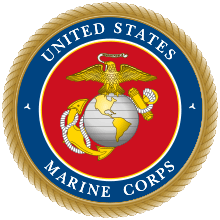Surveillance, Reconnaissance, Intelligence Group
Surveillance, Reconnaissance, Intelligence Groups (SRIG) were intelligence units of the United States Marine Corps from 1988 to 1997. The SRIG command structure combined units of Radio Battalion, ANGLICO, Force Reconnaissance, remotely piloted aircraft, counterintelligence, and other intelligence elements of the Marine Air-Ground Task Force.[1][2][3]
Mission

According to the SRIG doctrinal manual, SRIG's mission was "to provide surveillance, reconnaissance, intelligence, counterintelligence, electronic warfare, air and naval gunfire liaison, tactical deception, maritime direct action and secure communications to MAGTFs.[4]
History
The concept of the SRIG grew out of the Surveillance and Reconnaissance Center (SRC), created in 1969 to coordinate III Marine Amphibious Force's operations in the Vietnam War.[3]
The first SRIG to be activated was the 2nd SRIG, in October 1988, under the command of the 2nd Marine Expeditionary Force at Camp Lejeune. 1st SRIG was activated in October 1989 at Camp Pendleton, and 3rd SRIG in October 1990 at Camp Hansen, Okinawa.[1]
SRIG's first combat missions came during Operation Desert Storm. Members of 1st SRIG took the first Iraqi prisoners of the war,[5] and later helped coordinate naval artillery and air strikes in the Battle of Khafji.[2]
1st SRIG's activities in Somalia included Operation Restore Hope from 1992 to 1993 and Operation United Shield in 1995.
In October 1997, the SRIGs were dissolved and individual units were placed under the direct command of their respective MEFs.[3]
References
- Leard, Thomas E (1991). Marine Corps Intelligence for War as it Really Is (PDF). Naval Postgraduate School. pp. 36, 52–57.
- Halberstadt, Hans (1993). U.S. Marine Corps. Zenith Imprint. p. 63. ISBN 0-87938-769-6.
- Meyer, Bruce F (2004). Fortune Favors the Brave. Macmillan. p. 244. ISBN 0-312-99680-2.
- FMFM 3-22
- Morris, David J (2005). Storm on the Horizon. Random House. p. 171. ISBN 0-345-48153-4.
